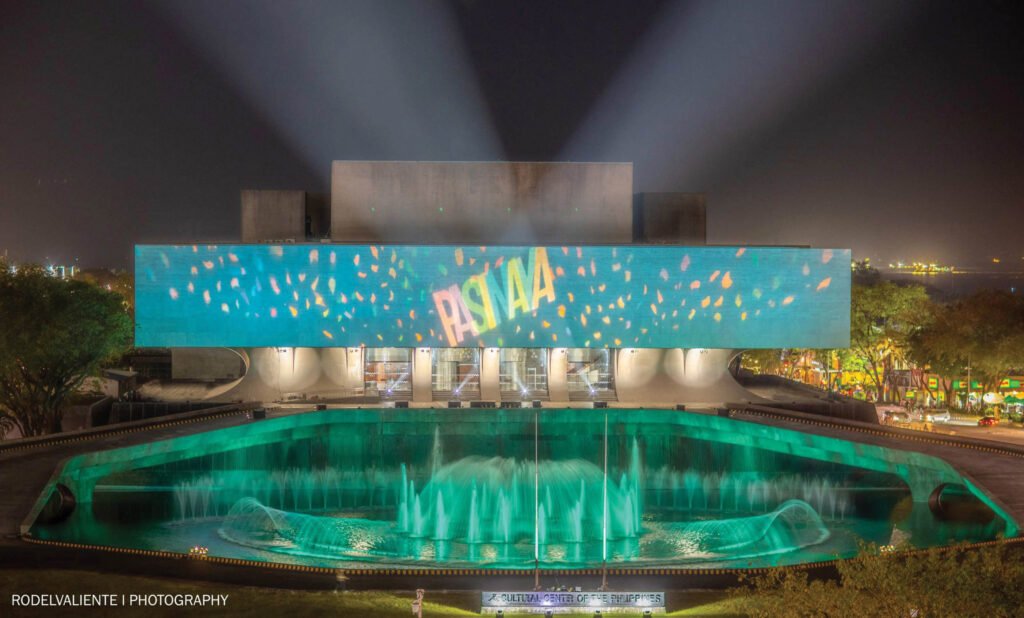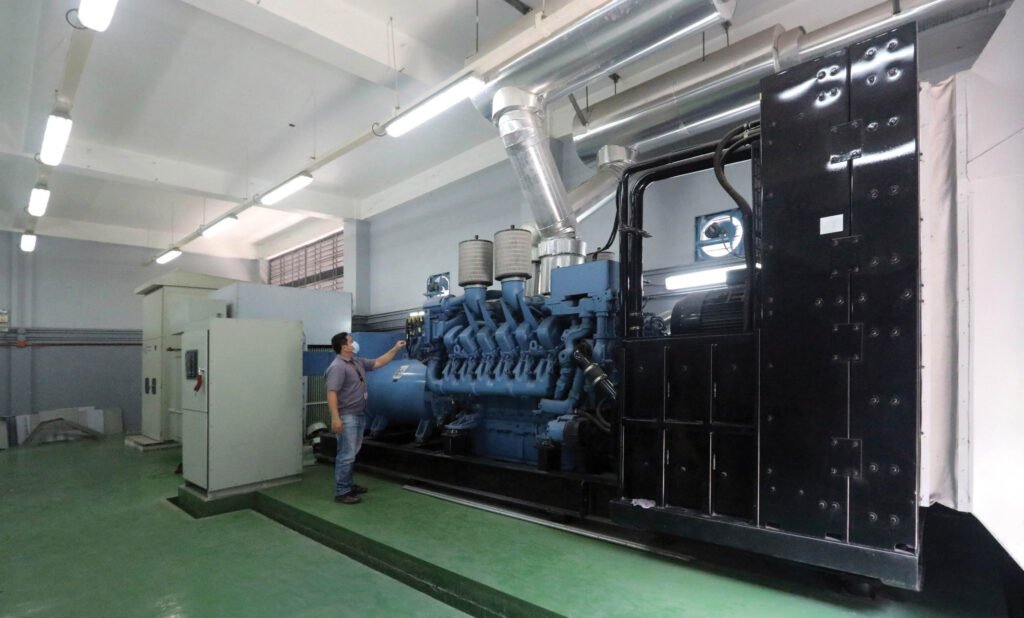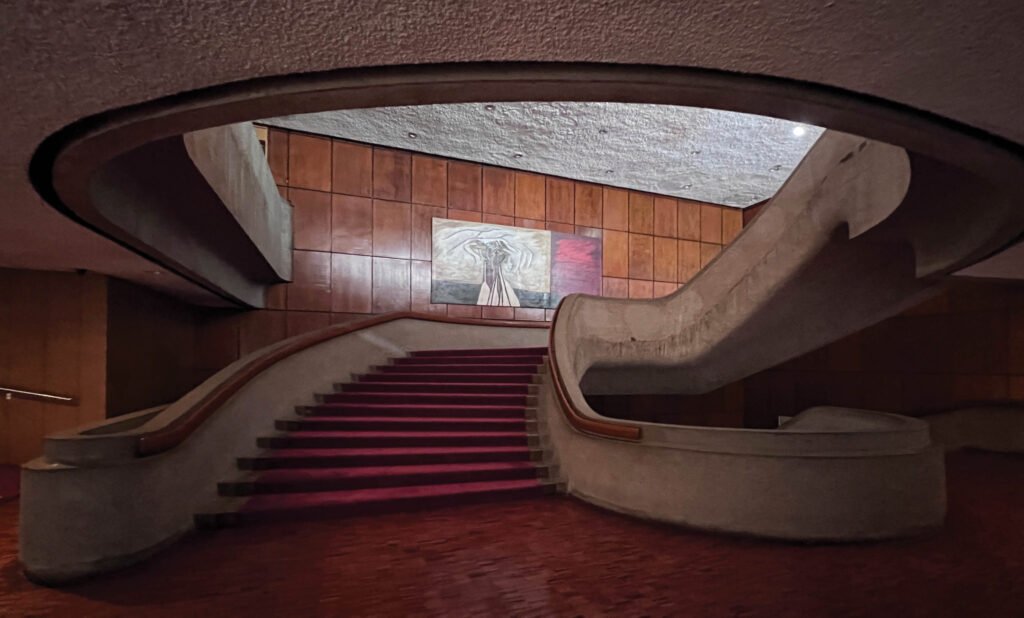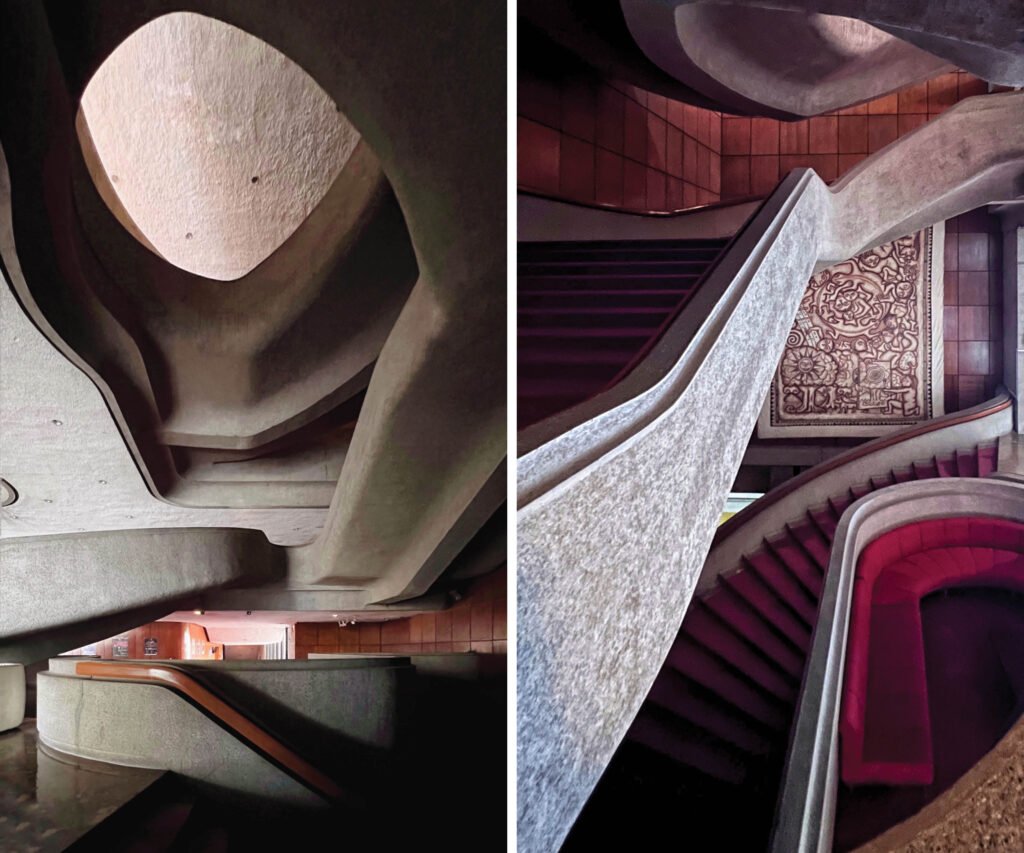Words The Cultural Center of the Philippines and the Kanto Team
Photos The Cultural Center of the Philippines and Patrick Kasingsing


Editor’s note: 53 years since its completion in 1969, the Cultural Center of the Philippines’ (CCP) Tanghalang Pambansa (National Theater) is as arresting as ever, its iconic Brutalist silhouette still turning heads from its seaside throne along Roxas Boulevard. It is widely considered by Filipino architects and design enthusiasts as among the best works (if not the best) of National Artist for Architecture, Leandro Valencia Locsin, who also penned more architectural gems within the complex. Sadly, one Locsin-designed building in the CCP, the PHILCITE Building, has long been demolished, and might soon be followed by the Folk Arts Theater if the recent plans to redevelop it as an indoor venue push through.
Behind its stoic façade, the celebrated theater building is showing its age; on our last visit in April 2022 for the Thirteen Artists Awards exhibit, some escalators are out of commission, poorly-lit corners, the once plush carpeting in need of a good dusting, and more worryingly, a small portion of a hallway’s interior ceiling has collapsed with the surrounding area cordoned off with scaffolding. It was a regrettable sight, to see this revolutionary piece of Filipino architecture ambling in old age, especially in contrast to the daring works of art by the young artists hosted in the exhibition.
It is with a measure of relief, after multiple instances of Locsin buildings meeting the wrecking ball (and coming within hair’s breadth of one, as is the current case of the Ramon Cojuangco Building) that the CCP is embarking on a three-year-long program to revitalize the structure. What follows is an abbreviated account from their press release highlighting the objectives and goals of the upcoming rehabilitation. The team hopes that the center follows through on its promise to stick close to the architect’s original vision, as it works to lengthen the lifespan of what is arguably one of the country’s most important architectural landmarks.


CCP Plans Rehabilitation of its 50-Year-Old Main Building
June 20, 2022, Cultural Center of the Philippines
Turning 53 this year, the main building of the Cultural Center of the Philippines will finally have its long-overdue facelift through a three-year rehabilitation plan starting this year until 2025. The plan emanated from the building audit done from 2018 to 2019, which became the basis for what needed to be addressed and rehabilitated.
“The building audit diagnosed the extent of the repair needed. The evaluation of the data gathering indicated that there are problems with multiple-site damages such as leaks, corrosion, and structural weaknesses brought by water seepage, earthquakes, and fatigue. Further, we have to update the Center’s fire protection, environmental protection, and other building codes,” shared CCP chairperson Margie Moran-Floirendo.
The entire project costs approximately PHP950 million; PHP440M has been earmarked for the first phase, and PHP515M for the second phase which will include the renovation of the hydraulic pit, the freight elevators, light and sound systems for the theaters.



The rehabilitation project of the Tanghalang Pambansa (CCP Main Building) begins on the fourth floor, roof deck, and the Tanghalang Aurelio Tolentino (CCP Little Theater). Next two years, the plan targets the other floors. Renovation works will continue to the upper and lower basements until 2025. “The priority right now is the Tanghalang Aurelio Tolentino (CCP Little Theater). When we installed the new escalators, from the ground to the top floor, we realized that the flooring of the Main Theater lobby escalators is directly connected to the ceiling of the LT backstage. We need to repair the ceiling,” said CCP administrative manager Teresa Rances.
Based on the plan, the Tanghalang Nicanor Abelardo (CCP Main Theater) will be the last to be rehabilitated, probably starting in 2024. This includes the renovation of the hydraulic orchestra pit, which has not been changed since it was installed in 1969.
The freight elevator, which is often used to bring massive sets, heavy equipment, and musical instruments straight to the theater stage, will also find a new lease in life. Both theaters have flooring problems, and wooden planks on the walls have termite infestations that must be addressed. The building foundation will have some strengthening works, but its overall condition is still quite stable.
“When CCP was built in 1969, they used good construction materials. 50 years later, the building has no major structural problems even with the major earthquakes and other natural phenomena we have experienced. We might not be able to see underneath the sea level. There are portals that support the CCP building, we can’t go further than that. There are cracks on walls, but the foundation is still stable,” shared Rances.
“When CCP was built in 1969, they used good construction materials. 50 years later, the building has no major structural problems even with the major earthquakes and other natural phenomena we have experienced.”


The CCP plans to construct a new outdoor cistern tank at the South Parking area to supply water to the Main Building and the nearby Production Design Center (PDC). It will also supply water to the Fire Protection System, which will be built side by side with the cistern tank. It will generate water for the sprinklers. Although a foam-type fire system has been installed in areas where artworks are located to protect CCP’s valuable assets.
“Originally, the water source was located at the ASEAN Park. But that became the sewage treatment plant. The CCP worked on it during the pandemic to make sure that clean water goes out to the bay, and whatever we process in the sewage plant can be used to water plants around the complex,” shared Rances. Currently, the sewage plant is connected to the CCP Main Building and the PDC. This year, the CCP intends to connect the Tanghalang Ignacio Gimenez (CCP Black Box Theater) and the Finance/Administrative Building to the plants.
“Some of these renovations have been done at the height of the COVID-19 pandemic. We have started upgrading our mechanical, electrical, plumbing, and fire system. We will also start the structural retrofitting. We start with what we can with the budget that we have,” said Rances. Some works that have been done included: changing the centralized air-conditioning system from a single 350-capacity unit to six units of 60-ton cooling units. Glass window panels were replaced, as well as carpets and marble trims.


The fountain has been refurbished. Nozzles and fixtures were repaired, and lights were replaced with LED lights. The chandeliers have undergone rehabilitation too. “We were lucky to be able to tap the same companies that designed and built the fountain and chandeliers in 1969. When we bid out the fountain renovation, the daughter of the original designer sent their proposal. It was the same with the chandeliers,” shared Rances.
The rehabilitation plan takes into consideration the current environmental conditions, including the effects of climate change. Take, for instance, the two major power banks, as well as the generator, have been transferred from the lower basement to the new Power Center in the South Parking area.
“Because of climate change, the surge of water is quite different now. There was a time when establishments around the complex and along Roxas Boulevard were flooded due to a typhoon. The lower basement is already below sea level, and we anticipate that the water could surge in, reach the power banks, and might cause an explosion. By bringing them out, we hope to prevent that kind of problem in the future,” shared Rances.
The materials used for the rehabilitation–from the kind of waterproofing, the replacements for the corroded parts, and the type of cement, among others–have been studied and considered to adapt to the current climate.


“We move slowly but surely. Every detail is being studied, from the materials down to the work itself. We look for the best possible options. Being by the bay in reclaimed lands needs thorough consideration,” said Rances.
The CCP makes sure that it remains true to the original blueprint designed by National Artist Leandro Locsin, hoping to preserve it to the extent possible.
While the rehabilitation is underway, the Center plans to document the process and share it with the community, particularly the architecture students, through various platforms. This can be used as a reference for the rehabilitation of architectural heritage buildings and other cultural sites in the country.
CCP president Arsenio J. Lizaso iterates that the center is a source of pride for all Filipinos, and a showcase of the best of Philippine art and culture: “The Filipino audience deserves a national center of culture where they can enjoy the arts in comfortable surroundings redesigned for the times. Our artists need new and better stages and venues to showcase and display their talents and abilities. We need venues that can fit more modern productions, as well as globally-competitive staging facilities and equipment. We need training facilities for our actors, dancers, and other performers.” •
Edits were done for brevity




One Response